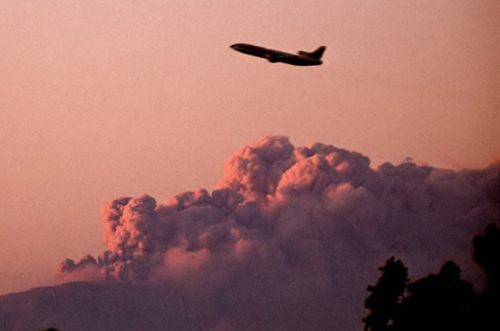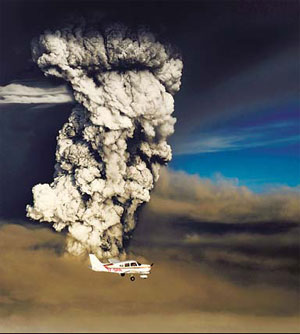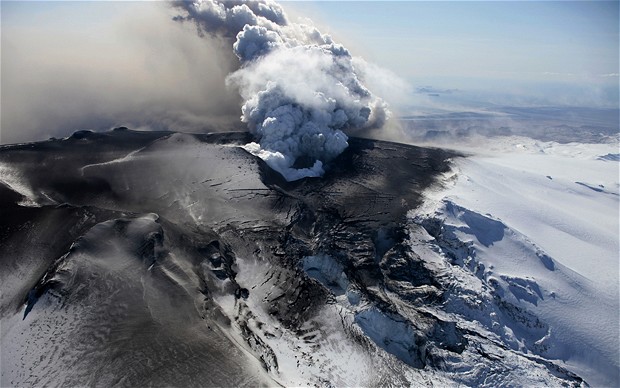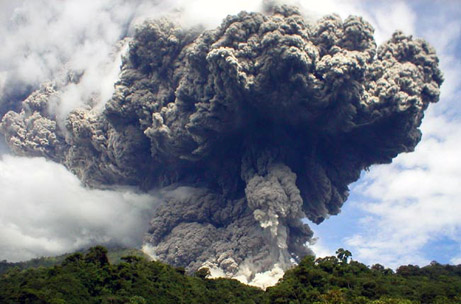| Cloudthreat by Transport Risk Management   Cloudthreat is an innovative international aviation insurance product created by Transport Risk Managment, Inc. to manage the risk and losses associated with Volcanic Ash and Volcanic Eruption. Cloudthreat was created in shortly after the eruption of Alaska's Mount Redoubt on March 22, 2009 which caused substantial losses to the aviation industry both in terms of revenue and physical damage to aircraft. Since that time, we have seen larger and more destructive eruptions around the globe resulting in truly catastrophic losses to the aviation industry. In the past 30 years, more than 90 jet-powered commercial airplanes have encountered clouds of volcanic ash and suffered damage as a result. The increased availability of satellites and the technology to transform satellite data into useful information for operators have reduced the number of volcanic ash encounters. However, further coordination and cooperation, including linking operators and their dispatchers to the network of government volcano observers, is required throughout the industry. Manufacturers have always advocated that flight crews avoid volcanic ash clouds or exit them immediately if an encounter occurs. Manufacturers also recommend specific procedures for flight crews to follow if they cannot avoid an encounter. Future Cloudthreat products will include coverage for losses associated with Aviation Weather Modification and Unmanned Aerial Systems (UAS) and Unmanned Aerial Vehicles (UAV). SPECIFIC FLIGHT CREW ACTIONS REQUIRED IN RESPONSE TO ENCOUNTERS Despite ongoing avoidance efforts, operators can still experience volcanic ash encounters. Guidance on the operational issues surrounding volcanic ash is divided into three aspects: avoidance, recognition, and procedures. The following information is general; flight crews should refer to their respective company's operating manuals for details. Avoidance. Preventing flight into potential ash environments requires planning in these areas: - Dispatch needs to provide flight crews with information about volcanic events, such as potentially eruptive volcanoes and known ash sightings, that could affect a particular route.
- Dispatch also needs to identify alternate routes to help flight crews avoid airspace containing volcanic ash.
- Flight crews should stay upwind of volcanic ash and dust.
- Flight crews should note that airborne weather radar is ineffective for distinguishing ash and small dust particles.
Recognition. Indicators that an airplane is penetrating volcanic ash are related to odor, haze, changing engine conditions, airspeed, pressurization, and static discharges. - Odor. When encountering a volcanic ash cloud, flight crews usually notice a smoky or acrid odor that can smell like electrical smoke, burned dust, or sulfur.
- Haze. Most flight crews, as well as cabin crew or passengers, see a haze develop within the airplane. Dust can settle on surfaces.
- Changing engine conditions. Surging, torching from the tailpipe, and flameouts can occur. Engine temperatures can change unexpectedly, and a white glow can appear at the engine inlet.
- Airspeed. If volcanic ash fouls the pitot tube, the indicated airspeed can decrease or fluctuate erratically.
- Pressurization. Cabin pressure can change, including possible loss of cabin pressurization.
- Static discharges. A phenomenon similar to St. Elmo's fire or glow can occur. In these instances, blue-colored sparks can appear to flow up the outside of the windshield or a white glow can appear at the leading edges of the wings or at the front of the engine inlets.
Procedures. The following nine procedures are general recommendations. Each operator's flight operations manuals will include more specific directions. - Reduce thrust to idle immediately. By reducing thrust, engines may suffer less buildup of molten debris on turbine blades and hot-section components. Idle thrust allows engines to continue producing electrical power, bleed air for pressurization, and hydraulic power for airplane control.
- Turn the autothrottles off. This prevents the engines from increasing thrust above idle. Ash debris in the engine can result in reduced surge margins, and limiting the number of thrust adjustments improves the chances of engine recovery.
- Exit the ash cloud as quickly as possible. A 180-deg turn out of the ash cloud using a descending turn is the quickest exit strategy. Many ash clouds extend for hundreds of miles, so assuming that the encounter will end shortly can be false. Climbing out of the ash could result in increased engine debris buildup as the result of increased temperatures. The increased engine buildup can cause total thrust loss.
- Turn on engine and wing anti-ice devices and all air-conditioning packs. These actions improve the engine stall margins by increasing the flow of bleed air.
- If possible, start the auxiliary power unit (APU). The APU can power systems in the event of a multiple-engine power loss. It can also be used to restart engines through the use of APU bleed air.
- If volcanic dust fills the flight deck, the crew may need to use oxygen. Use flight deck oxygen at the 100 percent setting. Manual deployment of the passenger oxygen system is not required because it will deploy automatically if the cabin altitude exceeds 14,000 ft.
- Turn on the continuous ignition. Confirm that autostart is on, if available. In the event that the engines flame out or stall, use appropriate procedures to restart the engines. During restart, the engines may take longer than normal to reach idle thrust due to the combined effects of high altitude and volcanic ash ingestion. If an engine fails to start, try restarting it again immediately. Flight crews should remember that the airplane may be out of the airstart envelope if the encounter occurs during cruise.
- Monitor engine exhaust gas temperature (EGT). Because of potential engine debris buildup, the EGT can climb excessively. The flight crew should prevent EGT exceedances. Shut down the engine and restart it if the EGT is approaching limits similar to a hung start.
- Fly the airplane by monitoring airspeed and pitch attitude. If necessary, follow the procedure for flight with unreliable airspeed.
|  

  | Transport Risk Management, Inc. 12424 Big Timber Drive Suite 5
Conifer, CO 80433 Phone: 720.208.0844 Toll-free: 866.256.0227 Fax: 720.208.0845 Email Cloudthreat TM
Copyright © 2009-2013 Transport Risk Management, Inc. | |